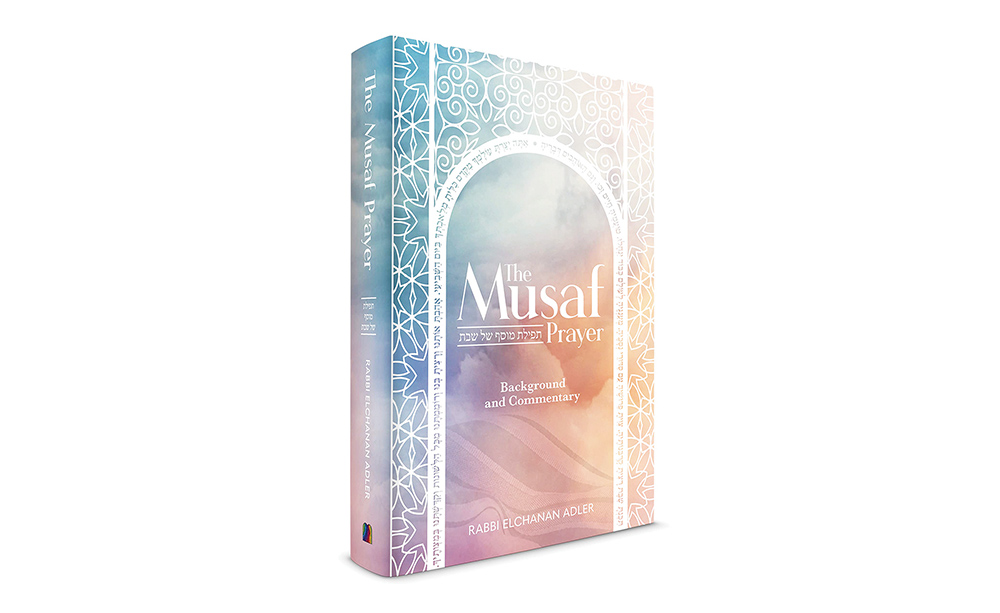
Reviewing: “The Musaf Prayer: Background and Commentary,” by Rabbi Elchanan Adler. Mosaica Press. 2023. English. 230 pages. ISBN-13: 978-1957579412.
The Tefillas Musaf of Shabbos is familiar and sacred. After Shacharis and krias haTorah, the chazan approaches the bimah and begins Musaf with Yekum Purkan. The shul is full. Old and young—as one—experience spiritual elevation highlighted by the sweet melodies during chazaras hashatz, simultaneously both sentimental and fresh.
But what is the message of Musaf? A wonderful new sefer by Rabbi Elchanan Adler, shlita, titled, “The Musaf Prayer: Background and Commentary,” provides the answer.
Rabbi Adler is a rosh yeshiva in Yeshiva Rabbeinu Yitzchak Elchanan (RIETS) who studied in the Mirrer Yeshiva and Yeshivas Beis Yosef, Novardok, and received semicha from Harav Dovid Feinstein, zt”l. Rabbi Adler is an eminent expert on biur tefillah and is a popular speaker and writer on tefillah and hashkafa. His new sefer is an English adaptation of his Hebrew sefer, “Eis Lechenena,” and is based on the popular shiurim that Rabbi Adler delivers in Passaic.
The sefer provides a backdrop and context to the elements of the Shabbos Musaf Shemoneh Esrei that emphasize the holiness of the day, beginning with “Tikanta Shabbos.” These include a yearning for the opportunity to offer the korbanos, sacrifices, once again in the Beis Hamikdash and the rewards reserved for those that observe the Shabbos and delight in it. Rabbi Adler masterfully delves into each element of the bracha, with an emphasis on the sources and variations in the nusach and various meanings of the reverse aleph-bais acrostic in Tikanta Shabbos, and much more. The sefer also explores Musaf of Shabbos Rosh Chodesh, in which Atah Yatzarta replaces Tikanta Shabbos. Rabbi Adler shows that elements of Atah Yatzarta are taken from Shabbos Musaf, the weekday Rosh Chodesh Musaf and the Yom Tov Musaf and explores why the Musaf of Shabbos Rosh Chodesh includes these elements. Halachic issues related to the Musaf of Shabbos Rosh Chodesh are also explored.
Rabbi Adler provides remarkably detailed insight into each word of the Tefillas Musaf. Here are three samples:
- The conventional translation of the words, “Tikanta Shabbos” is “You established the Shabbos.” Rabbi Adler shows that “tikanta” has—in fact—multiple interpretations, each allowing for a deeper understanding. “Tikanta” can mean “You numbered,” through which Rabbi Adler’s connects Shabbos to the servitude in Egypt. “Tikanta” can mean “You prepared,” connected to the idea of Hashem preparing Shabbos as the purpose and goal of creation. “Tikanta” can be an allusion to a “solution” through which it can be connected to the establishment of eruvin, as an eruv is a solution through which people can leave their locations on Shabbos. “Tikanta” can also mean “You clarified,” through which Rabbi Adler connects it to the idea that Hashem clarifies the Shabbos day as special and unique.
- Rabbi Adler provides interesting insights into the three expressions in the Tefillas Musaf that describe those that observe Shabbos: “meangeha,” “toameha” and “haohavim devareha.” These expressions are superficially similar: “Those who delight in it,” “those who savor it,” “those who love its words.” Rabbi Adler illustrates how these three expressions refer to three levels of greatness when observing Shabbos. Rabbi Adler then delves into the topic further, exploring and reconciling the views of the Vilna Gaon and the Beis Halevi surrounding whether enjoyment on Shabbos should be lishma, or whether eating on Shabbos is a mitzvah, even if one intends for his own enjoyment.
- In elaborating on the words, “Az miSinai nitztavu,” Rabbi Adler delves into a fascinating discussion relating to the evolution of the mitzvah of Shabbos, from Marah through Har Sinai. He also notes the importance of the different nusachos following the words, “Az miSinai.” The nusach Ashkenaz version differs from the nusach Eidot Hamizach and nusach Sephard version. While these differences may seem inconsequential, Rabbi Adler shows how they may—in fact—reflect how and when Shabbos received its full sanctity and unique character.
“The medium is the message” is an expression—coined in the last century—that argues that the way in which a message is conveyed communicates as much as the message itself. This idea can be applied to Tefillas Musaf. The beauty and warmth of the “medium” of the Musaf davening is directly aligned with its message: it is a taste of the reward to come if the “message” of Musaf is fulfilled. Rabbi Adler’s wonderful sefer, “The Musaf Prayer: Background and Commentary,” is an important step for anyone looking to make their Tefillas Musaf on Shabbos more meaningful.









